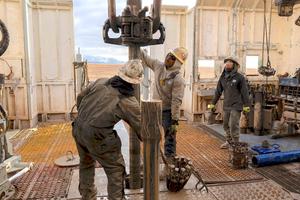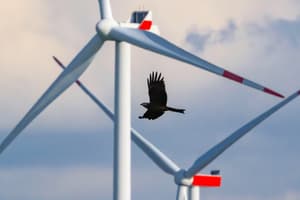Despite the inevitable decline of coal, the government continues to waffle in the face of industry pressure.
Under pressure at home and abroad, the government is making plans for life without coal: In its new draft climate plan, the climate ministry recently said that the percentage of power generated by coal will have to fall by as much as half by 2030, to as low as 37 percent of electricity generation. By 2040, the ministry said, coal could be generating as little as 11 percent of Poland’s electricity as European carbon pricing makes coal even less economical.
Yet, despite the inevitable decline of coal, the government continues to waffle in the face of industry pressure. The miners’ unions still wield clout. Government plans to shut down two aged mines in southeastern Poland this year were scuppered when the miners’ unions — whose members take to the streets of Warsaw when their interests are at stake — objected.
“The problem is that there’s still no official schedule and strategy for the transition of the [Polish] energy sector,” says Katarzyna Michałowska-Knap of the Institute for Renewable Energy in Warsaw. “Our leadership has never defined how we’re going to fix it. We’re still so dependent on coal that they see it as technically impossible.”
Zbigniew Karaczun, an energy expert at the Polish Climate Coalition, an NGO umbrella organization, adds that ruling party politicians “realize very well that the mines have to be closed and that Poland has to do more to support renewable energy. But they’re afraid to do it.”
The government’s tough choices can be eased by the EU, which is offering generous aid to help cushion the blow to mining regions. The EU’s Just Transition Fund, which has 2 billion euros ($2.36 billion) in grants and investments earmarked for Poland, was conceived with Poland’s dilemma in mind as a means to help it transition to a low-carbon economy. The fund will support clean energy research and development, retraining of workers, environmental rehabilitation, and the reduction of emissions at carbon-intensive industrial facilities.
The Bełchatów mine and power plant. The mine is the largest coal reserve in Poland, with an estimated 1,930 million tons of lignite coal available. Phil MacDonald/Wikimedia Commons
Europe is moving aggressively to phase out coal as it doubles down on its goal of becoming the world’s first climate-neutral continent. In Brussels, European Commission President Ursula von der Leyen has put the European Green Deal and the fight against the climate crisis at the heart of all EU policy. If Europe’s leaders have their way, the EU will up its pledge to cut its carbon emissions by 2030 to 55 percent below the 1990 level, a target that will be very hard to hit without Poland fully on board. Experts say that this ambitious target would require shutting down all coal-fired power plants in Europe by 2030 — a far cry from Poland’s desire to keep some coal plants operational until 2049.
Across the continent, carbon pricing and the falling costs of wind and solar power have sent coal into a tailspin. Since 2012, coal production in Europe has dropped by nearly half. The price of coal has plummeted since 2018, but so, too, have the costs of natural gas and renewables, making them a better buy than the dirty fossil fuel. Today, Poland’s antiquated mining operations and low-quality coal can no longer withstand these new economic and political realities.
“The economic outlook for coal [in Poland] has gone from dire to impossible,” said a recent report from the environmental law organization, Client Earth.
The pressure on Poland to wind down its coal industry is coming from many corners — and all at once. In Poland itself, smog-blanketed cities and villages, and massive coal market subsidies have stirred popular resentment. Between 2013 and 2018, Poland spent 6.8 billion euros ($8 billion) propping up the largely state-owned coal sector through direct payments and electricity price subsidies.
The costs of the EU’s carbon-trading scheme have staggered the Polish energy sector and industry.
Indeed, coal-generated heat and power is only getting more expensive — in Poland and across Europe — in large part because of the EU’s rising price on carbon emissions, a central pillar of its fight against climate change. Through the EU’s carbon trading scheme, polluters pay per ton of carbon dioxide released into the air. For years the price was very low and had a negligible impact on emitters. But since 2018, carbon permit prices for the energy sector and industry have quadrupled, and will only shoot up further over the next decade.
Yet Poland’s ruling Law and Justice Party vigorously defends coal production from a hail of criticism — from the European Union, from European and Polish environmentalists, and from citizens fed up with the onerous smog. Poland remains the only EU country not to share the union’s mid-century decarbonization goals.
“The government feels huge pressure from Brussels,” says Joanna Maćkowia-Pandera, head of the Warsaw-based think tank Forum Energii, “But Polish industry is complaining loudly, too, because the price of wholesale energy is higher than in neighboring countries. Even the utilities are ready to transform, because Poland needs new generating capacities and renewables are cheaper.”
The costs of the EU’s carbon-trading scheme have staggered the Polish energy sector and industry, even rendering some key energy-intensive industries — such as iron and steel — uncompetitive. Poland’s coal stockpiles are full, yet the country is actually importing coal from Russia because it is of higher quality and is less expensive. The irony of importing Russian coal is dark as Poland’s leaders had long seen its domestic coal as a form of energy security — primarily against its historical foe, Russia.
Warsaw, Poland's capital, shrouded in smog in 2015. The country has some of the poorest air quality in Europe. Radek Kołakowski/Flickr
The government has complained bitterly to the EU about the escalating price of carbon, and has even threatened to quit the carbon trading scheme and create its own kinder carbon-pricing regime. But participation in the EU scheme is compulsory: Poland’s exit from the carbon market might well jeopardize its membership in the EU.
“The politicians can keep screaming as loudly as they like, but the economy faces dire consequences if we don’t phase out coal as quickly as possible,” says Joanna Flisowska, head of the climate and energy unit of Greenpeace Poland. A coal phaseout by 2035, paired with dynamic growth of renewable energy sources, is the only way forward for the Polish economy, argues Greenpeace.
Smog is fueling disaffection with coal among growing numbers of Poles. In Europe, only the air quality in Bulgaria ranks lower than Poland’s. In the hardest-hit cities and towns, people sometimes wear masks in the streets and keep their windows tightly shut. An estimated 48,000 Poles a year perish from illnesses related to air quality, and organizations like Smog Alert have rallied opposition to air pollution and turned it into a political issue. Greenpeace estimated that nearly two-thirds of the country’s kindergartens are in heavily polluted areas.
“Our children are suffocating from smog and our government, instead of investing in clean technologies, invests in Russian coal and does not allow Poles to use European green money,” said Polish opposition politician Malgorzata Kidawa-Blonska, referring to monies such as those of the Just Transition Fund.
Studies show that Poland is well-suited for solar power and onshore and offshore wind energy.
And though Poles have been slow to come around, renewable energy now enjoys broad support. Ever-more Poles are bolting solar panels to their roofs. Last year, clean electricity generation jumped by 6 percent in Poland, with onshore wind leading the way. In 2019, renewables accounted for 15 percent of Polish electricity production — a record.
Studies show that Poland is well-suited for solar power, onshore and offshore wind energy, and geothermal. Poland’s greatest renewables potential lies with wind, but in a sign of how far behind Poland remains, the country’s first offshore wind turbine is not expected to come online until 2025. Germany boasts 10 times the onshore wind capacity of Poland. But experts say that conditions off Poland’s Baltic Sea coast — including strong winds and shallow waters — are ideal for the giant turbines that now define the coasts of the U.K., Germany, and Denmark.
After years of blocking clean-energy initiatives, the government is now cautiously encouraging renewables expansion with feed-in tariffs, tax relief, and loan schemes. Experts such as Michałowska-Knap of the Institute for Renewable Energy say the government has to do much more, including redesigning the power grid to accommodate energy generation from a variety of decentralized sources.
The conundrum Poland’s leadership now faces won’t resolve itself without a major break from the past, whether this suits coal miners or not. If Poland fails to commit to the EU’s net-zero emissions plan and timetable, half of its share of Just Transition Fund monies will be withheld and could go to other EU member countries, European Council President Charles Michel said earlier this year.
“We have no option but to change,” says Maćkowiak-Pandera of Forum Energii. “This means we have to invest in future-oriented sectors and not those of the past. New industries will create many more new, better jobs.”





